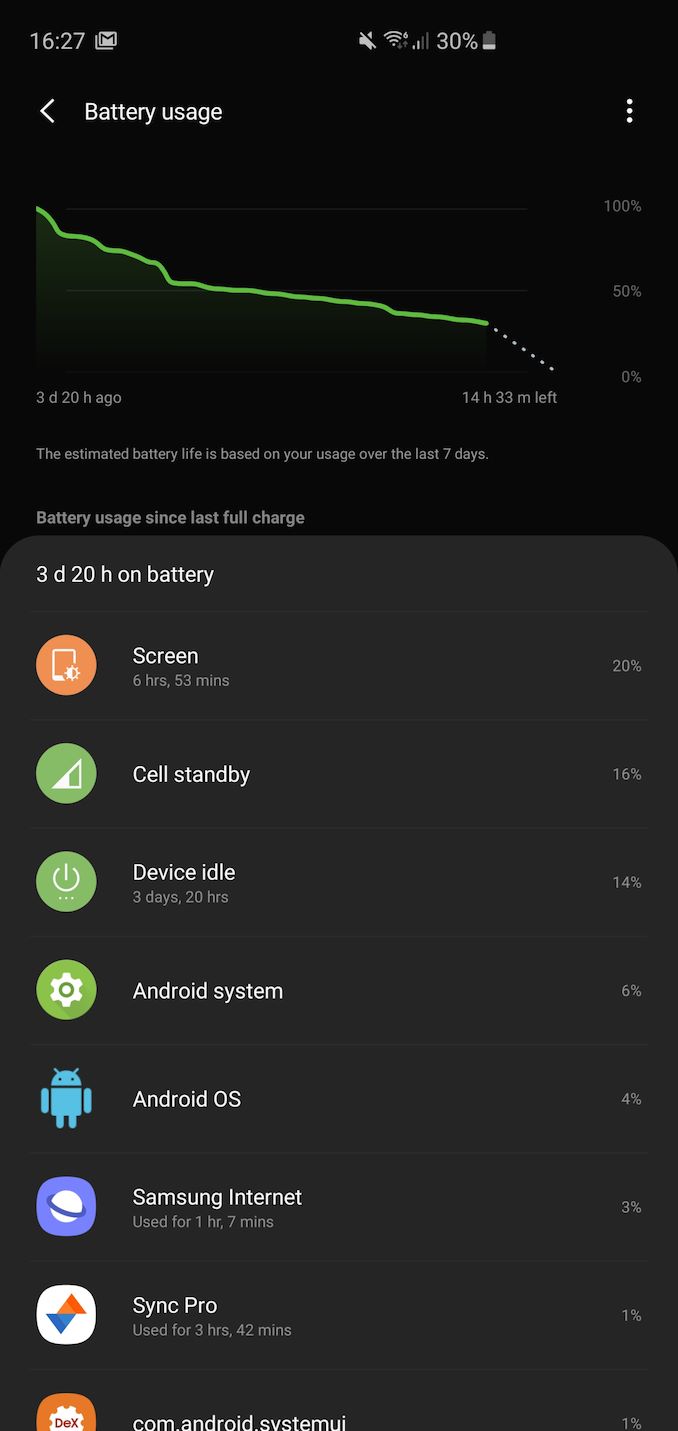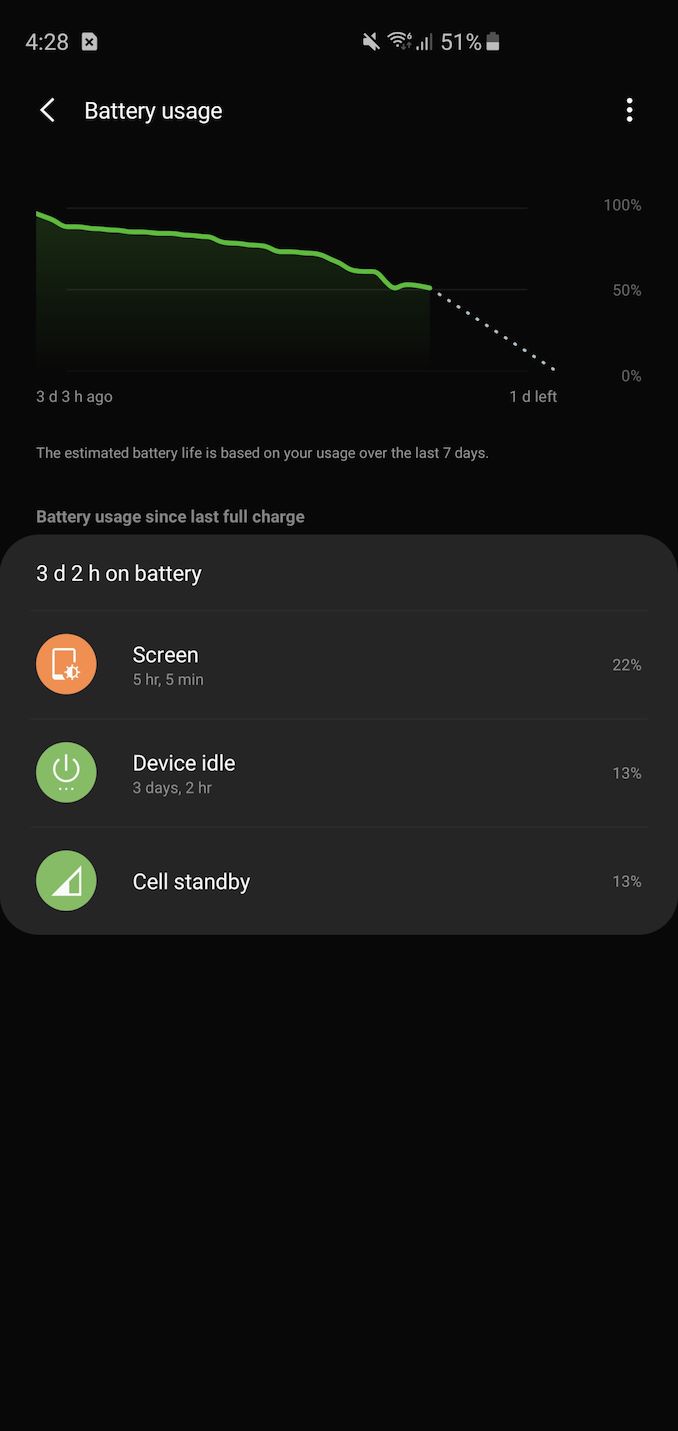The Samsung Galaxy S10+ Snapdragon & Exynos Review: Almost Perfect, Yet So Flawed
by Andrei Frumusanu on March 29, 2019 9:00 AM ESTBattery Life: Impressive
Battery performance of the Galaxy S10+ has been touted to be as class-leading. The introduction of a larger battery, more efficient screen as well as a new generation of SoCs are sure to bring improvements over last year’s Galaxy S9. One aspect that readers will have waited for impatiently is our testing of the new Exynos 9820 variant against the Snapdragon 855, which has also been one topic I’ve been extremely interested to see.
We run Samsung's Galaxy devices at the full potential they can deliver, something we've done for several generations now. This means that the screen resolution is set to the native 1440p of the display panels, and the new battery settings on the S10 were also set to "Performance" mode.
Without further ado, let’s get do the results:

In our web browsing test, both Galaxy S10+s are showcasing outstanding longevity at 13.08h for the Exynos and 12.75h for the Snapdragon variant. Least to say, I was extremely surprised to see this result even though we measured the Exynos 9820 CPU to be quite less efficient than the Snapdragon 855 in peak performance efficiency. I would have not expected the Exynos to match the Snapdragon, much less slightly beat it.
Before going into more details, let’s see the PCMark battery test results:

Here, in absolute terms, the Galaxy S10+ aren’t quite as impressive as on the web test and further lag behind the excellent results of the Kirin 980 devices. Nevertheless, these are some impressive figures and again it’s very good to see that both units are almost evenly matched, this time the Snapdragon unit lasting slightly longer than the Exynos.
To explain these results, we have to keep one thing in mind: the Exynos unit will have posted worse performance than the Snapdragon, so it will have spent more time at the lower more efficient frequency states.
One thing that I also noticed, is that in very low idle loads where there’s just some light activity on the A55 cores, the Exynos 9820 variant actually uses less power than the Snapdragon unit. The figures we’re talking about here are 20-30mW, but could possibly grow to bigger values at slightly more moderate loads. It’s possible that Qualcomm has more static leakage to deal with on the 7nm process than Samsung on 8nm, one thing that I’ve come to hear about the TSMC 7nm node.
Furthermore, one of the biggest improvements for the Galaxy S10 over past devices isn’t actually the SoC nor the actual bigger battery. It’s actually the display as well as the base power consumption of the phone. In Airplane mode, the base power has gone down by almost 100mW compared to the Galaxy S9+ which is a fantastic development and is especially something that will result in higher low-brightness battery life.
Currently in my time with both S10+ units, I can say they’ve been among the longest lasting Android devices I’ve tested.


Exynos vs Snapdragon in identical usage patterns & Prolonged idle periods
One issue I can confirm with the Exynos unit is that after a voice call in any app, the phone isn’t correctly entering its lower power state, and will suffer from increased idle battery drain until a reboot. This is something that hopefully Samsung addresses in a firmware update as it doesn’t look to be a hardware related issue. When not affected by this bug, both phones idle very similar to each other and slightly better than the S9+ I use as my daily device.










229 Comments
View All Comments
nathanddrews - Friday, March 29, 2019 - link
I was on my 3rd new battery, so it wasn't that.id4andrei - Saturday, March 30, 2019 - link
I'd say Google Play services updates. To mitigate the lack of OEM Android upgrades Google made Android more modular. Google Play services are the glue that keep old phones running the latest apps. On the other side the phone is rather old and every successive service update keeps raising the hardware requirements.Gastec - Saturday, March 30, 2019 - link
Or due to Google Play Services, as with my brand new S7 right from the beginning.nicolaim - Friday, March 29, 2019 - link
The bixby button isn't locked:https://www.theverge.com/2019/2/20/18233819/samsun...
nathanddrews - Friday, March 29, 2019 - link
Not anymore. It was out of the box.0ldman79 - Saturday, March 30, 2019 - link
I think part of it is the scripting and stuff going on in the background, expecting faster hardware.Various apps, The Chive for example, uses the default browser as part of it's function (or it used to at least) so my old S4 with 4.3 (I blocked the update, broke apps I use) had issues with the app.
Also, Facebook, Messenger, etc, are resource hogs and you can't even kill them. If they are installed then they are running 24/7. Even using a third party, even rooted app, to kill them, they keep coming back. The only way to get rid of them is to remove them from the phone. They auto-load 2 seconds after the task is killed, even when blocking auto-start of apps.
If Facebook is built in like it was on my old LG phone you're just screwed. I couldn't even disable it on that one. Root and removed it eventually, doubled the speed of the old phone.
Achtung_BG - Friday, March 29, 2019 - link
Kirin 980 scored significantly better results in Spec2006(prf/w) vs 9820, despite appearing 6 months earlier.Snapdragon 855 is the king of 2019
Irish910 - Friday, March 29, 2019 - link
But the A12 still beats them all at the Spec2006. Even the A11 is far superior to the 855Cheesydieper - Friday, March 29, 2019 - link
You're talking about benchmark numbers which is really nothing, Caused I've seen note 8 and 9 beating XS max in real life performancedudedud - Friday, March 29, 2019 - link
"real life performance"Let me guess, opening apps?